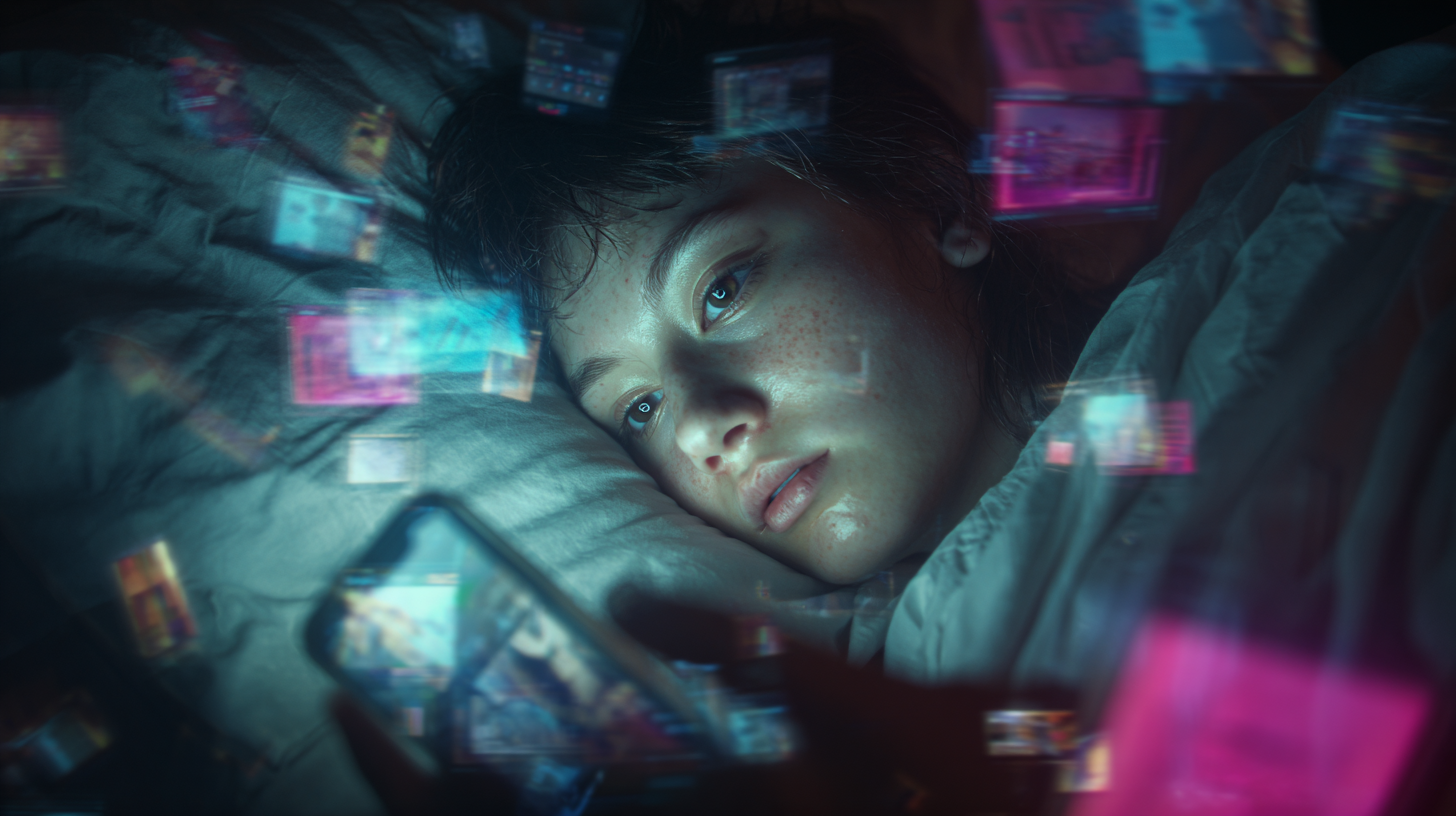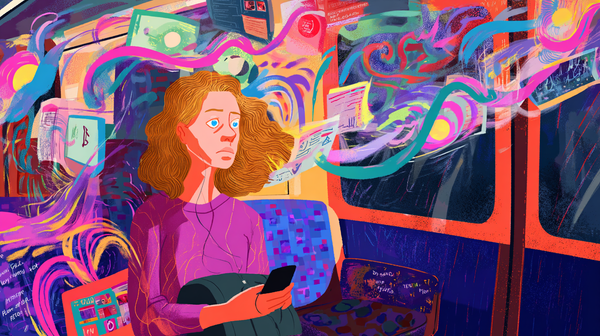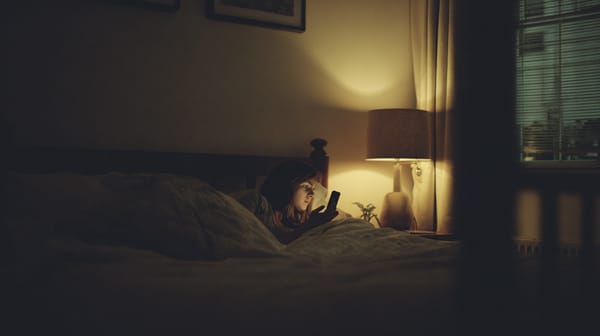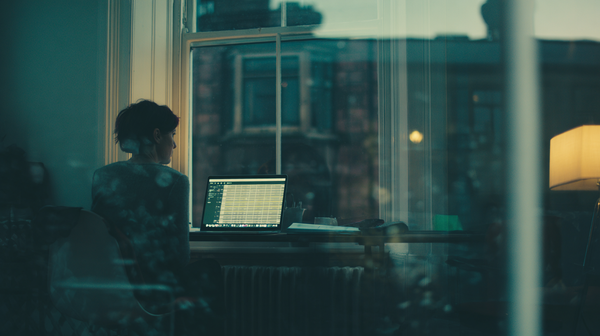TikTok and Derealisation: How the Infinite Scroll Is Warping Our Sense of Reality
Derealisation used to follow trauma. Now, therapists say it's showing up after TikTok binges. The Disquiet investigates how algorithmic design is reshaping the texture of reality itself.

The Disquiet is a dispatch from the frontlines between mental health and the modern world - where psychology meets culture, technology, and the quietly unraveling self. Each Field Report explores a single phenomenon shaping the texture of our inner lives today.
Where the static begins
At 3 a.m., a teenager lies in bed, face lit by the ghost glow of her phone. A blur of clips-whispered storytimes, shifting POVs, oversaturated filters. She scrolls until the world around her feels oddly two-dimensional.
In the morning she tells a friend:
"Everything looked fake until I turned my phone off."
That eerie flatness has a name. Derealisation-the sense that the world has slipped half a second out of sync. Its twin, depersonalisation, makes the self feel distant, as if you're watching life rather than living it. Clinically, both sit under Depersonalisation/Derealisation Disorder (DPDR), recognised by the American Psychiatric Association as a dissociative condition often triggered by anxiety, trauma, or sensory overload.
What's new isn't the symptom. It's the trigger. A growing number of young people now trace their episodes not to trauma, but to the architecture of the feed itself.
What's happening here?
Scroll through r/derealization or TikTok's #dpdr tag and the pattern repeats:
"After hours on TikTok, my hands don't feel real."
"POV videos give me panic and I zone out."
TikTok's design rewards constant novelty-a variable-reward loop psychologists compare to slot machines. The average clip lasts less than 30 seconds. Each swipe promises something stranger, funnier, sadder. The brain's reward circuitry fires; attention tightens.
Over time, this rhythm scrambles the body's sense of duration and space. Studies show infinite-scroll interfaces distort time perception and overload sensory integration-the very conditions that can tip an anxious mind into dissociation.
Writer Kyle Chayka calls it algorithmic anxiety; "a sense that our perception is being outsourced to machines." The feed doesn't just show the world; it trains us to experience it at the machine's tempo.
Where does this come from?
TikTok didn't invent derealisation-but it industrialised its triggers.
Attention loops once found in casinos now sit in our palms. The design principle of "frictionless flow" removes every pause that might let the nervous system reset.
Each swipe delivers a new sensory payload: rapid edits, shifting faces, the faint hum of background music.
The result? The brain learns to anticipate interruption. The body's sense of continuity-what philosophers call presence-fractures into feed-length fragments.
The internet's early utopians promised connection; what we got was perpetual partial attention.
What is this really about?
TikTok's answer to pain is usually style. So derealisation has become its own visual genre: misted filters, ambient loops, captions like "I don't feel real anymore."
Creators call it the DP/DR aesthetic. What began as solidarity has blurred into symptom contagion.
A 2024 MindSite News investigation showed how TikTok's algorithm amplified Dissociative Identity Disorder content until identification and illness became indistinguishable. The same mechanics-repetition, resonance, endless surfacing-now swirl around derealisation videos.
The irony is painful: people seeking relief from numbness are offered more clips that aestheticise numbness.
As media psychologist Pamela Rutledge notes, immersive audiovisual design can entrain mood and perception without the viewer realising it. Translation: watch enough content about feeling unreal, and your brain may begin to oblige.
What this reveals about us
Therapists are hearing the language of DP/DR in new accents:
"It started after a TikTok binge."
"I keep checking if my face is real."
Research on socially learned symptoms shows that expectation and exposure can manifest as genuine bodily sensations. During the pandemic, neurologists documented waves of TikTok tics-functional tic-like behaviours spreading via social video.
No one's saying derealisation is contagious. But the precedent is clear: the mind learns by watching.
Layer on sleep deprivation, anxiety, and the dissociative pull of endless novelty, and the line between symptom and side effect blurs.
A 2024 study of 3,300 young adults linked problematic smartphone use with higher depression, stress, and dissociation scores.
This isn't moral panic-it's design realism. If certain interfaces reliably leave users anxious, numb, or disoriented, that's not overuse-it's a design outcome.
Why it matters now
Clinicians are quietly rewriting intake forms. Alongside sleep and substances, many now ask:
"What platforms are you using, and when do the feelings start?"
New best practices are emerging:
- Digital grounding - sensory resets before and after scrolling (the 5-4-3-2-1 method).
- Algorithmic hygiene - turning off autoplay, reseeding feeds with slower content.
- CBT for DPDR - reframing catastrophic thoughts and practising external focus.
- Sleep discipline - no feeds in bed; brightness tied to daylight.
These aren't cures. They reintroduce friction-something algorithms have spent a decade erasing. And friction is a precondition for agency.
Who's accountable for unreality?
Platforms insist their goal is connection, not dissociation. Yet none publicly track post-feed disorientation or time-loss metrics, even though Meta's internal research acknowledged "session regret" as a measurable outcome.
The UK Online Safety Act and EU Digital Services Act now require platforms to assess "systemic risks" to wellbeing. But derealisation isn't yet in the taxonomy of harms.
Algorithm-induced derealisation isn't a pathology of individuals-it's weather created by the attention economy.
The Next Frontier of Unreality - Beyond the feed
If a phone screen can warp perception, what happens when the screen surrounds you?
Early VR studies show short sessions can trigger mild DP/DR-like symptoms and lingering "cybersickness". Apple's Vision Pro safety notes list disorientation and difficulty concentrating as side effects.
We are entering an age where unreality is a design variable. The question isn't whether people will feel detached-it's whether anyone will measure, publish, or mitigate it.
The echo
None of this means TikTok or VR headsets cause derealisation. It means their design rhythms overlap with the body's dissociation pathways: sensory flood, temporal blur, emotional numbing.
For most users, that means fatigue. For some, it tips into panic. What would responsible design look like?
- Break reminders keyed to scroll speed, not just screen time.
- Public release of wellbeing metrics.
- Independent studies tracking perceptual after-effects.
Until then, the burden falls on individuals and clinicians to rebuild grounding one sense at a time.





